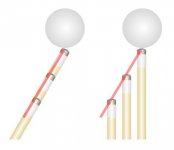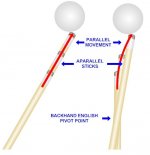New Stroke Situation
Side spin or side english or hitting the cueball not at its center is what I am citing as stroke for this post. The desired effect from the stroke is to get the cue ball to move sideways.
The next three situations demand a shot on the 5, pocketing the ball closest to the cue ball is not allowed, it is a constraint (restriction or limitation).
The first shot is the perfect reflection shot, meaning you can hit cueball center and level and on the natural aiming line to pocket the 5 ball (orange colored). It is well known that 'brewsters angle' dictates how to aim and pocket the kick.
View attachment 180816
What happens for situations where the cue ball and the object ball are not perfectly lined up.
One diamond length from the ideal situation with the same constraints is the next situation:
View attachment 180817
Two diamond lengths from the ideal situation with the same constraints is the next situation:
View attachment 180818
Common to the last two situations is the cue ball must travel the same sideways distance to pocket the 5 with a kick.
Since spin is being applied the diamond aiming system must be modified.
I will not discuss those modifications, they are pretty simple to discover.
SUGGESTION: Since the sideways distance the cueball travels is the same, that implies you use the same amount of "side-ward stroke."
Question: How is the aiming point on the rail in the last two shots related to the aiming point on the rail in the first shot?

